Archive for the ‘packaging’ Category
By: Pakarada Premtitikul
General Manager
InterDry (Thailand) Co., Ltd.
A study on a few typical shipments and the effect on Temperature and Relative Humidity.
Let’s have a look at three commonly used shipping routes and what this does to the temperature and humidity inside the shipping container.
We’ve chosen three routes, namely Japan – Netherlands, Japan – Memphis and Japan – Portland.

Typical Conditions
A normal shipment consists of three distinct stages. The first stage includes the time from container filling until the container is loaded onto a ship. This includes road transportation and brief periods of storage. Daily cycles of temperature and humidity are common. For example, figure 2 includes temperature swings of 40° F [22°C] during the first stage of a shipment from Japan to The Netherlands.
The second stage is the actual time at sea or aboard a ship. This may or may not be the longest stage during the container’s journey. During this stage, daily cycles of temperature and humidity are usually very minor or completely non-existent. Temperature changes are gradual, often occurring over days rather than hours. Occasionally, a single temperature/ humidity cycle occurs as the ship makes stops along the route, however extreme conditions are rare. Figure 3 includes a slow temperature rise and fall as a winter route takes the ship near the equator and then north to The Netherlands.
The final stage begins when the container is removed from the ship and continues until the recorder is removed during the freight unloading process. This may include varying periods of time spent in customs, on trains, on trucks, and in storage. Daily temperature and humidity cycles are common and may be extreme.
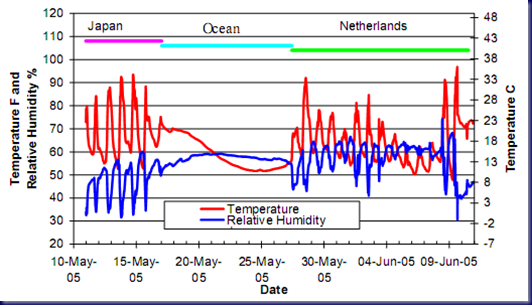
Typical summer shipment – Japan to the Netherlands
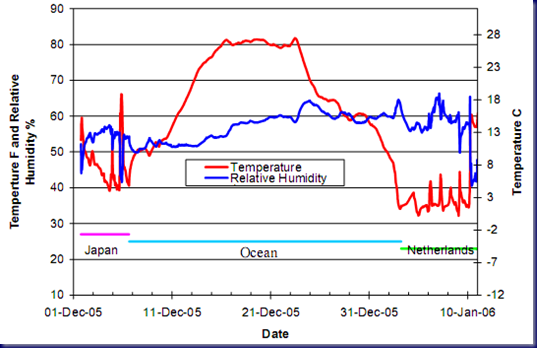
Typical winter shipment – Japan to the Netherlands
Extreme Conditions:
Some of the most interesting recordings are the extreme conditions. The highest recorded temperature occurred on July 25, 2005 during a shipment from Japan to Memphis. The temperature reached 135° F [57° C] during the third stage of this shipment (figure 7).
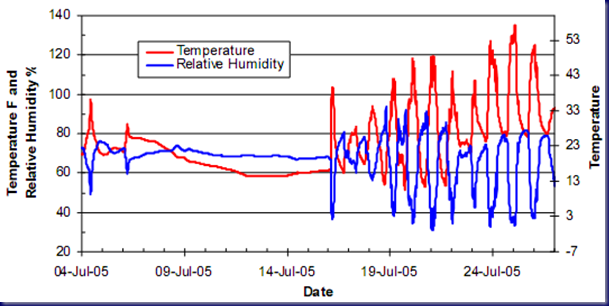
Hottest shipment 135°F (57°C) – Japan to Memphis (USA).
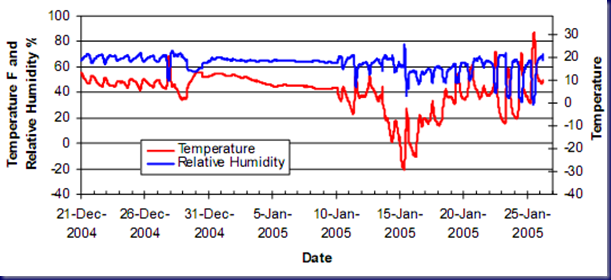
Coldest shipment -21°F (-29° C) – Japan to Memphis (USA).
The lowest recorded temperature occurred on January 15, 2005 also along the Japan to Memphis route (figure 8). The temperature dropped to -21° F [-29° C], which is slightly beyond the recorder’s published temperature range.
The shipment with the highest relative humidity occurred during a trip from Japan to Portland. The relative humidity was recorded at 96% on August 5, 2005 while the container was on land. Figure 6 shows the detailed temperature and humidity profile. The most extreme humidity conditions are seen during periods of large daily temperature changes. In this example, as the temperature slowly drops from 88° F [31° C] to 67° F [19° C] over 9 days, the humidity increases to 88% before returning to 79%. However, starting on August 4 as the temperature dropped from 121° F [49° C] to 68° F [20° C] over a 16 hour period, the relative humidity rose from 32% to 96%. The corrugated boxes seem to absorb moisture fast enough to temper humidity during slow changes in temperature while at sea. However, rapid temperature changes seen on land seem to exceed the rate at which the corrugated boxes can absorb moisture.
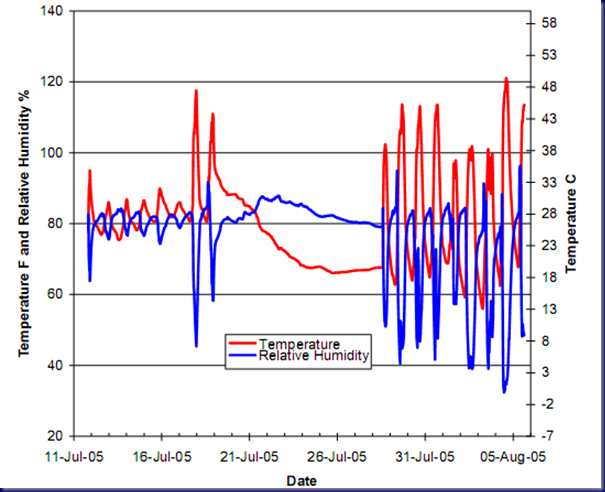
Highest relative humidity 96% – Japan to Portland (USA).
Be sure to check out the following page for more information on how desiccants can save your valuable cargo:
InterDry Thailand
http://bit.ly/99j2NX
1. What is Relative Humidity (RH)? Relative humidity measures the amount of moisture in the air. It is expressed in a percentage of how much moisture the air could possibly hold. The wetter or damper the air is, the higher the relative humidity. The drier the air feels, the lower the relative humidity. Thus, 100% humidity is actually rain.
2. When stuffing a container in any climate, you also stuff the actual humidity contained in the air at the place of packing.
3. When closing the container, the humidity is contained in a very small space. As the container is moved from one climate to another, the humidity vaporizes up into the ceiling of the container, where it will start to rain down onto the cargo. Either the humidity will start to soak into the cargo or run along the surface of i e steel products. It can also turn into water that runs towards the bottom of the container. Nordic Power Desiccant actually "catches" the moisture before it vaporizes.
4. As soon as the climate changes, the moisture will either vaporize again or really start making trouble among your different products being shipped, if you do not use a desiccant. The longer the transportation time – the more damage may possibly develop.
5. You may have seen your cargo being loaded in perfect condition. But have you ever opened a container full of moulded furniture? Or rusty motor equipment? Or rice sacks full of mildew? Or fruit covered in fungus? The customers do not like it. They will blame you. They will lose money and time, they will lose their customers and they will make claims to you. Then you will lose money and time, and possibly even the client. Since there are many parties along the transportation chain, many may be blamed for damaged goods – like manufacturers, traders, shipping lines and forwarders. Why be among them?
6. Other desiccants being used are i.e. silica gel. Silica gel is the most common type of desiccant in use today. It is a porous sand and can absorb moisture in the air, often up to 40 % of it´s weight. However, silica gel absorbs moisture best in small, confined spaces and often end up getting saturated in a very short time span, making it unsuitable for container shipments. When saturated, it will not help catching the moisture anymore. Be aware that some silica gel – the blue contains cobalt – is toxic, and can not be disposed of any which way.
7. The best insurance there is – using Nordic Power Desiccants. The effect is 40 – 60 % better than other products in the market.
Leak Proof Our desiccants are packed in special Tyvek and Spunbond packing that allows only one way absorption, thus ensuring the desiccants are completely leak proof and efficient too.
Q: How do Nordic absorbers help to solve moisture problems?
Nordic absorbers contain Calcium chloride that very aggressively grab and absorb moisture from the air. They dry the air. When the air is dry, there are no moisture problems.
Q: Can Nordic absorbers solve all moisture problems?
Well, not all. Some cargoes may be so wet that any reasonable number of Nordic absorbers get overwhelmed. But Nordic absorbers can reliable protect even very difficult cargoes that may contain tons of moisture, such as coffee beans, wood products or paper.
Q: I load my container under dry conditions and it is very tightly sealed. How come I still experience moisture problems?
Your cargo or the packaging, including container floors, pallets and crates, contain moisture that is evaporated into the air during transport. Wet packaging material is the most common cause of unexpected moisture problems.
Q: I have shipped the same cargo for years with Nordic absorbers without any trouble, but now I have a lot of damage. Have you changed the poles?
Check your container and your packaging material. Did you just start to store your pallets outdoors? Does your forklift drive into the container with snow on the wheels? Did you just change supplier of crates? You can’t tell by looking whether wood are carton is dry. The moisture properties of wood and cartons have an exponential character. It makes a huge difference if your pallets moisture content should be 20% instead of 17%, say.
Q: I ship consumer goods in tubes/cans/jars etc that contain no moisture, yet I still have problems.
Consumer goods are often shipped with a lot of cardboard packaging. Even if the boxes seem dry they could literally hold tons of water.
Q: Each container of my cargo of peanuts/coffee/cocoa contains tons of moisture. What difference does it make that Nordic absorbers absorb a few litres during a voyage?
All the important things that happen have an exponential character. That means that a small change in circumstances can have a huge effect on the outcome. Nordic absorbers create circumstances that allow almost all of the moisture to remain in the cargo even while the level of humidity in the air is lowered by a crucial amount, sufficient to prevent damage. It is a question of ”leverage”.
Q: Does it make a lot of difference that my cocoa beans have a moisture content of 8% instead of 7%?
Yes, such a difference could be all the difference between no damage and disaster. The moisture behaviour of most agricultural products have a strong exponential character.
Q: My cargo of peanuts had suffered damage in the centre even though the outside of the cargo looked fine and there was were no signs of condensation?
Lots, if not most, damage to cargoes is caused by prolonged periods of elevated humidity without any condensation (Container rain, Container sweat, Super Saturation Event). It is common that cargoes loaded at cool temperature and then moved into warm condition suffer damage in the centre of the cargo as a result of a difference in temperature between the outside and the centre of the cargo. Warm air from the outside of the cargo becomes humid as it moves into the cooler centre. Nordic absorbers protect against this effect even though the absorbers are mounted on the container walls.
Q: I had damage to my cargo even though I used lots of silica gel and there was no condensation. Would it help to switch to Nordic absorbers?
Calcium chloride absorbs moisture even when the humidity is not very high. This protects the cargo against damage caused by prolonged periods of elevated humidity. Some kinds of steel start to corrode at 70% relative humidity, moulds can grow at 80% relative humidity and at near 90% relative humidity lots of things go wrong. Yet, Nordic absorbers are also at their most efficient protecting against condensation. Most other products, such as silica gels, are really effective only in very humid conditions and in protecting the cargo against condensation damage.
Q: What is so great about Nordic absorbers anyway?
Well, they will not fall off the wall, get punctured during loading and unloading, leave a wet puddle on the cargo or run out after half the voyage. They are installed in seconds without ladders and take up no cargo space. The capacity of each absorber is big, so fewer is required. The cost of an installation is very competitive, even against much inferior alternatives.
Q: How many absorbers do I need?
The number of Nordic absorbers required to protect the cargo depends on the cargo, the temperature conditions during the voyage, the length of the voyage – and just how safe you want to be. For some really dry cargoes e.g.. steel coils or household removals, 2-3 Nordic absorbers are enough. For a lot of ”normal” goods 4-6 Nordic absorbers is about right. Some cargoes with very difficult moisture properties on long voyages may require up to 16 Nordic absorbers.
Q: Do I need to line my container with kraft paper?
Lots of containers are lined with Kraft paper primarily for reasons of hygiene or to simply isolate the cargo from direct contact with the container walls. The liner will act as a kind of sponge, catching and absorbing any droplets of water and then re-evaporating the moisture into the air. If liner is used without Nordic absorbers it could contribute top a kind of pumping effect, drawing moisture out of the cargo. When used together with Nordic absorbers the liner will act as a buffer in extreme conditions, and will prevent any container rain from reaching the cargo. Much the same can be said for so called dew cloths.
Q: My container is absolutely filled with cargo. Will the Nordic absorbers still work?
Moisture diffuses very effectively, even through a seemingly compact cargo. Experience shows that Nordic absorbers will make a difference even to mould growth inside cartons in the cargo. It is, however, necessary that some free space is left in front of each Nordic absorbers. If some Nordic absorbers have collected less water than others inside a container, there may be a problem with air access to those absorbers.
Q: I have problems with mould growth inside my shrink-wrapped pallets. Will Nordic absorbers help?
Yes, so long that there is some access of air through the top and bottom of the pallets. If this is not possible, a spiked roller may be used to tear holes in the shrink wrap.
Q: My shipments of steel/galvanised components/aluminium/machinery etc arrives corroded, stained or discoloured despite heavy packaging. Will Nordic absorbers help?
You can forget about your Tectyl, coatings, oil-paper and plastic wraps that are expensive both to apply and remove. Your container can probably be equipped with a sufficient number of Nordic absorbers to protect against any damage at less cost than your present packaging.
Q: I got some brine on my hands while removing used Nordic absorbers . Is it dangerous?
No it isn’t. Calcium chloride is non-toxic and environmentally safe. It is the second biggest constituent of sea-salt and is liberally sprinkled over icy roads in cold countries. The brine is somewhat similar to very salty seawater, and may cause irritation and rashes if left to dry on the skin. We recommend that you wear gloves and goggles when handling used absorbers, but should you get splashed by brine just wash off immediately with lots of fresh water.
Q: Can I re-cycle my used absorbers?
The absorbers can not be re-used but can be disposed of environmentally friendly. It doesn’t contain any harmful chemicals.
More information on desiccant and moisture
Calcium chloride based container desiccant to prevent moisture problems











